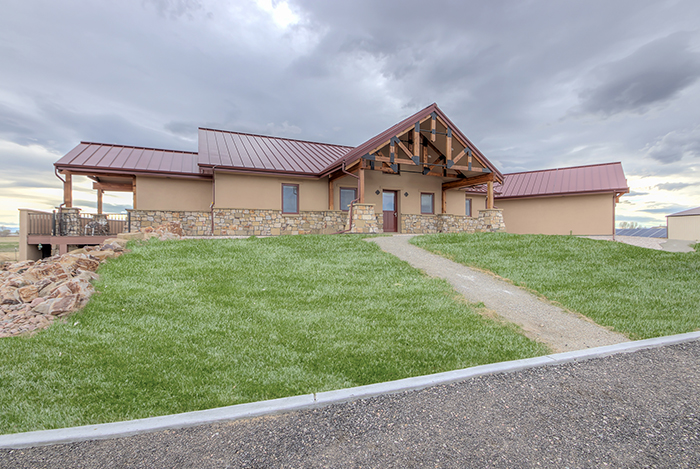
What would you say if I told you that this beautiful home is 4 times the size of the typical single family home but uses only half the energy? Amazing, right?
Vicki Hutchinson, the owner of Traveler’s Rest, a 6,800 SQFT Certified Passive House, was interested in building an energy efficient, green home which is what led her to finding us. Her only bill is electricity and last month it was $17!
She toured our 3,600 sq ft Passivista project in 2012, which prompted her to hire us for her new home build. In the same way that the Passivista house near Broomfield is an award winner (it received the Most Innovative Green Building Award 2014 from the Colorado Green Building Guild), Hutchinson’s house also received a prestigious award from the Guild – Best New Green Home in Colorado in 2014.
Vicki didn’t do it for the award, though. Having done renovation work on homes and work on government buildings before, she understood the value of energy efficiency and conservation, the core of Passive House principles. Having traveled quite often to numerous places around the world she was also really interested in building a quiet, comfortable home where she could rest from her excursions. Thus the name – Traveler’s Rest.

This desire for a combination of energy efficiency and comfortability seemed to her to fit perfectly with the Passive House principles. So she decided to build one and certify with Passive House Institute US, Traveler’s Rest.
So, what does it mean for a building to be built with the Passive House principles? It must be built to and modeled in accordance with these 7 principles:
- Use a Passive House energy model like WUFI Passive or PHPP to define the energy target you have to hit. You need a navigator to reflect material options and accurate energy usage.
- Defined insulation types and thickness to the climate. We see homes all the time with not enough clothes on (insulation) for their given climate.
- Airtight construction stops heat and moisture. Plugging air leaks can slow heat flow, as well, as air that moves through building usually carries a lot of heat with it. Also, we know that warm air holds more moisture than cold air, so when warm air leaks into wall cavities, it deposits that moisture. Then the warm moist air hits a cold surface, such as wall sheathing or drywall, depending on the season.
- Solid, uninterrupted insulation stops thermal bridges. In the process of wrapping a building with insulation, heat can no longer slip out through. Dense and continuous insulation keeps the inside cool in summer and warm in winter.
- Balanced ventilation ensures fresh air—and controls moisture. All this air tightening means that filthy, moist air isn't leaking into the building’s interior, which also means that air changes must be controlled with a proper ventilation system. This is why we use an energy recovery ventilator (ERV), which pulls fresh air in and pushes old air out while transporting heat and moisture in the process.
- Optimized windows let heat in when (and only when) you want them to. While the typical Energy Star windows in many homes is double glazed with argon gas, Passive buildings usually have triple glazing. Low-E coatings spread onto the surface of the glass can be adjusted to allow more or less heat gain. High solar heat gain windows are best used on sides of the house where winter sun is wanted: usually on the east and south sides. Low SHGC windows should be used where summer sun will do the most damage: usually west-facing windows.
- Very minimal heating/cooling systems, LEDs, e-star appliances or better is the final building requirements outside the e-star water sense. Because the building is tight, well-insulated, and has high-efficiency windows, large heating and cooling systems are not needed. This is where the upfront investment begins to pay off. Most of the money that was spent on insulation and windows can be recovered with a healthier environment inside and outside AND low or NO utility bills.

When speaking with a writer for the HomeLink magazine, Vicki said it best: “Passive house gives good quality construction and a fabulous end-product,” she said. “We tried to go green as much as we could, and all of that combined together creates low utility costs and a lovely home that is quiet and low maintenance. I think passive house is the way to go. We need to do more of that; we are running out of fossil fuel. Even with slightly increased cost, if we design and build (certified passive) from the get-go, it’s well worth it.”
If you’re interested in more ways to be kind to the environment and save money, you can check out how we can apply passive house principles to your home, church, office, apartment, library, maintenance building, or upload your plan sets so that you can reduce your energy bills to nearly nothing per month! We provide passive house services for: passive house Colorado, passive house Wyoming, and passive house Nebraska. In addition, breathe clean and easy with Airtight and Ventilation solutions at mainstreamcorporation.com we ship all over the place! We exist for the sole purpose of helping the world build healthier wealthier and wiser!

